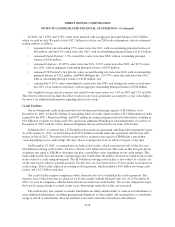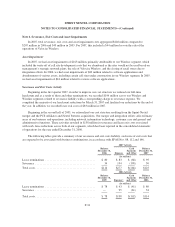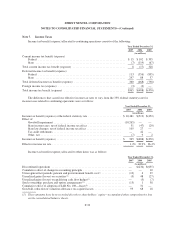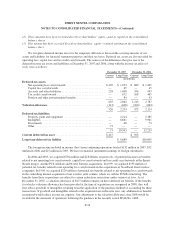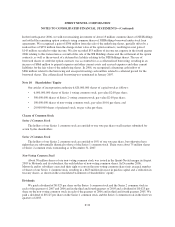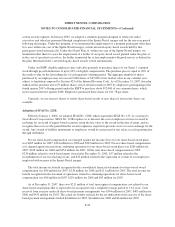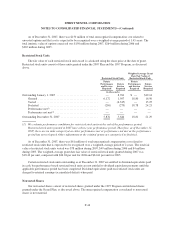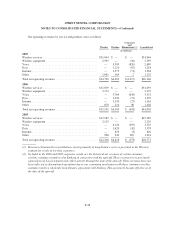Sprint - Nextel 2007 Annual Report Download - page 123
Download and view the complete annual report
Please find page 123 of the 2007 Sprint - Nextel annual report below. You can navigate through the pages in the report by either clicking on the pages listed below, or by using the keyword search tool below to find specific information within the annual report.SPRINT NEXTEL CORPORATION
NOTES TO CONSOLIDATED FINANCIAL STATEMENTS—(Continued)
Exposure to strategic investments in other companies includes the risk that unfavorable changes in market
prices could adversely affect earnings and cash flows. We may also obtain equity rights in other companies,
usually in the form of warrants to purchase common stock of the companies. These equity rights are typically
obtained in connection with commercial agreements or strategic investments.
Our foreign exchange risk management program focuses on reducing transaction exposure to optimize
consolidated cash flow. We enter into forward and option contracts in foreign currencies to reduce the impact of
changes in foreign exchange rates. Our primary transaction exposure results from net payments made to and
received from overseas communications companies for completing international calls made by our domestic
customers and the operations of our international subsidiaries.
Interest Rate Derivatives
As of December 31, 2007, we held fair value interest rate swaps with a notional value of $1.0 billion. These
swaps were entered into as hedges of the fair value of a portion of our senior notes and have maturities ranging
from 2008 to 2012. On a semiannual basis, we pay a floating rate of interest equal to the six-month LIBOR plus a
fixed spread and receive an average interest rate equal to the coupon rates stated on the underlying senior notes.
Our interest rate swaps meet all the required criteria under SFAS No. 133, as amended, in order to apply the
shortcut method of accounting for these instruments, as all of the critical terms of the swaps perfectly match the
corresponding terms of the hedged debt. Under the shortcut method, we can assume that our interest rate swaps
are perfectly effective in hedging our interest rate risk. We recognize all changes in the fair values of the interest
rate swaps currently as a gain or loss within other income (expense) on the consolidated statements of operations,
in accordance with SFAS No. 133, as amended. Under the shortcut method, these changes in the fair value of the
hedging instrument are offset by an equal change in the fair value of the underlying debt, with no impact on
earnings.
During the fourth quarter 2005, we entered into a series of interest rate collars associated with the issuance
of debt by Embarq at the time of its spin-off on May 17, 2006. These derivative instruments did not qualify for
hedge accounting treatment in our consolidated financial statements, and changes in the fair value of these
instruments were recognized in earnings from discontinued operations during the period of change. During 2006,
the fair value of these derivatives increased, resulting in a $43 million gain, after tax. These derivatives were
settled upon completion of the spin-off.
Equity Derivatives
In 2005, we entered into a series of option contracts associated with our investment in NII Holdings
designed to hedge our exposure to the risk of unfavorable changes in the price of NII Holdings’ common shares.
The first contract was written for 1.7 million common shares of NII Holdings and was not designated as a
hedging instrument. Therefore, changes in the fair value of the derivative instrument were recognized in earnings
during the period of change prior to settlement. We settled the first option contract on March 31, 2006 in
conjunction with the sale of 1.7 million common shares of NII Holdings. We recognized a gain of $37 million
from the sale of the underlying shares, partially offset by a loss of $23 million from the change in fair value of
the option contract during 2006, resulting in a net gain of $14 million recorded to other income.
The remaining option contracts were written for a total of about 13 million common shares of NII Holdings
related to the forecasted sale of those shares in the fourth quarter 2006 and were designated as effective cash flow
hedges of a forecasted transaction pursuant to SFAS No. 133, as amended, and Derivative Implementation Group
Issue No. G-20, Assessing and Measuring the Effectiveness of a Purchased Option Used in a Cash Flow Hedge.
F-38


